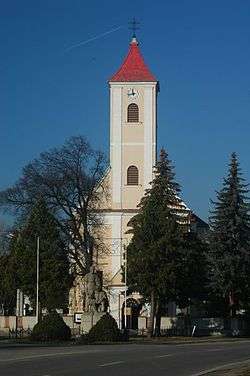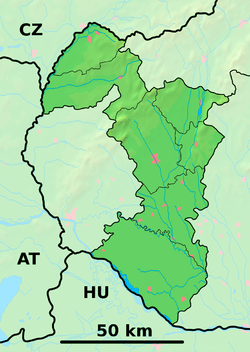Kúty
Kúty, (German: Kutti, Hungarian: Jókút) is a village and municipality in Senica District in the Trnava Region of western Slovakia.
Kúty | |
|---|---|
Village | |
 A church in Kúty | |
 Kúty Location of Kúty in the Trnava Region  Kúty Kúty (Slovakia) | |
| Coordinates: 48°39′20″N 17°01′10″E | |
| Country | Slovakia |
| Region | Trnava |
| District | Senica |
| First mentioned | 1392 |
| Area | |
| • Total | 27.158 km2 (10.486 sq mi) |
| Elevation | 156 m (512 ft) |
| Population (2017-12-31) | |
| • Total | 4,006 |
| • Density | 150/km2 (380/sq mi) |
| Postal code | 908 01 |
| Area code(s) | +421-34 |
| Car plate | SE |
| Website | www.kuty.sk |
History
The village was first mentioned in 1392 under the name Kuth. And in 1498 as Kwhty. Kút is equal to Corner - a distant place in the bend of rivers or roads or mountains.
The oldest archaeological find of historical settlement dates back to the Stone Age (2000 - 1900 BC) and later from the Bronze Age (1500 - 700 BC). Other archaeological finds are from the Iron Age of La Tène (500 - 0 after Christ) and from the pre-fortified and earlier fortified settlements in local parts Čepangát and Sigeca, in the historical confluence of the Morava and Myjava rivers.
In the Middle Ages, it belonged to the manor of Ostrý kameň, later to the Czobor family. In 1645 the village was burned down. According to a document from 1678, when there were three mills in Kúty, Count Adam Czobor donates one of the mills to Pavel Dopiera. Since 1736 the village was owned by the Habsburg family.
In 1707 the first mention of the Chapel of St. Anne appears in the documents. In 1717 - 1726 the church of St. Joseph the Foster Father was built in the village, in 1826 the bell tower and in 1841 the church tower was finished.
The oldest part of the village is the part of Kaniža, in its immediate vicinity there is a part of Hribov (behind the church in the direction of Břeclav) and part called The Village (Bratislavská street) with characteristic historical building structures oriented perpendicular to public roads and courtyards leading to the street.
Village symbols
The first seal of the village with a village coat of arms comes from the 17th century and characterizes the employment of the indigenous population - agriculture.
The village coat of arms is in a green shield, depicting a golden mouldboard in the upper part, and a silver plough underneath, with a green Mercury's rod on it (called caduceus). The mouldboard and plough symbolize agricultural tools. Mercury's rod symbolizes the geographic location of the village - the center of commerce, customs, and the intersection of major roads. The shield is in late gothic style. The colour of the coat of arms was chosen to match the basic rules of heraldry for the use of colours and metals.
The village flag consists of seven longitudinal stripes in green (1/8), yellow (1/8), green (1/8), white (2/8), green (1/8), white (1/8) and green (1/8) colours. The flag has an aspect ratio of 2: 3 and is finished by three points, i.e. two cuts, extending into one third of its field.
The symbols of the village Kúty are registered in the Heraldic Register of the Slovak Republic under the sign K-11/2002.
Geography
The municipality lies at an altitude of 156 metres and covers an area of 27.158 km².[1] It has a population of about 4,006 people.
Kúty is located in the western part of Záhorská lowlands, about 4 km east of the Morava River and the state border with the Czech Republic. The village adjoins the village of Brodské in the north, Čáry and Kuklov villages in the east, Borský Svätý Jur and Sekule villages in the south and the Moravian village of Lanžhot in the west.
Kúty is an important traffic junction; through the center of the village leads the road I / 2 from Malacky to Holíč, which is crossed by road II / 425 to Břeclav and II / 500 to Senica. West of the village, the D2 motorway leads from Bratislava to Brno. The eastern edge of the village is bordered by the Bratislava - Břeclav railway line, which is connected at the local station by lines to Sudoměřice and Trnava.
Importance
Kúty is one of the most important railway junctions in Slovakia, a meeting point of four lines. Being a railway border crossing, all trains travelling in the Prague-Bratislava railway corridor (including EuroCity trains) make a stopover in Kúty.
Personalities
Andrej Ľudovít Radlinský (1817–1879) - worked in the place and is buried there. He was a Slovak Roman Catholic clergyman, a linguist, a religious writer. He founded the Society of St. Adalbert and was a co-founder of Matica slovenská.
Prof. PhDr. Pavol Palkovič, DrSc. (1930–2009) - born on the spot. He was a university lecturer and a Slovak theatre and literary theorist.
Mgr. Jozef Mikuš, (1934–1997) - was born and buried there. He was a high school teacher, regional historian, promoter of regional history and one of the founders of St. Gorazd tradition.
References
- Mestská a obecná štatistika SR Archived 2008-01-11 at the Wayback Machine